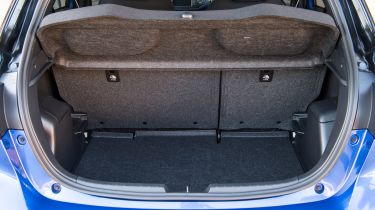Toyota Yaris Hybrid (2012-2020) practicality & boot space
Passenger space is clearly a Toyota Yaris Hybrid priority, but boot space isn't forgotten

| Length | Width | Height | Boot volume (seats up) |
|---|---|---|---|
| 3,945mm | 1,695mm | 1,510mm | 286 litres |
The Toyota Yaris wasn't conceived as the sportiest, most luxurious or prettiest car on the market. Its main objective is to be easy to live with, and you can see this in the way its interior is designed. What's more, the hybrid version isn't saddled with the compromises that affect some – carrying a bulky battery pack has no effect on interior or luggage space.
Toyota Yaris hybrid interior space, storage & comfort
The Yaris is a slightly unfashionable shape compared to its newer rivals, most of which have a lower, more curvaceous roofline in the quest for sporty looks. More fool them, you might think, when you settle behind the wheel of the Yaris.
The slight sense of claustrophobia that some superminis can instil is kept at bay by the wide expanse of glass. Driver and passengers alike get a good view out, and the seats are set a little higher than in many superminis. There's also lots of adjustment to the driver's seat, and a steering wheel that adjusts for angle and reach.
The Yaris Hybrid is only available with five doors, all of which open wide and make access to the front and rear seats a breeze. Passengers will be surprised by just how much space there is in the rear seats – the Yaris puts its bigger Auris stablemate to shame in this regard – and headroom is plentiful, too.
The floor is virtually flat, too, the absence of a 'transmission tunnel' means the centre rear passenger has somewhere to put their feet. There are cup-holders front and rear, deep storage bins in the front doors with purpose-shaped sections for drink bottles, a generous glovebox and a small cubby to take loose change and other sundries. All that's missing is somewhere convenient to keep a mobile phone.
Boot space
As mentioned above, clever packaging enables the Yaris Hybrid to house its bulky battery pack without sacrificing boot space. It boasts the same 286-litre boot as the petrol version, which makes it marginally smaller than the 292-litre Ford Fiesta and virtually on a par with the 285-litre Vauxhall Corsa.
You soon realise that the extensive rear-seat legroom comes at the expense of luggage space, but many will think that a sensible design decision. The rear seats can be folded with a 60:40 split if you need to carry something bulky, and dropping both back seats frees up a total of 786 litres of load space. The tailgate is wide and accepts bulky loads with ease, but the seats don't fold entirely flat and there's quite a high loading lip to negotiate.


